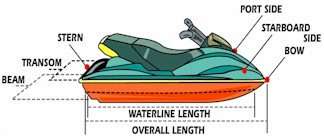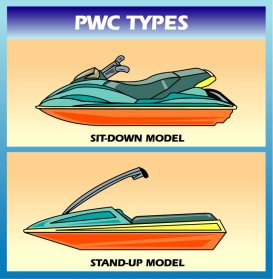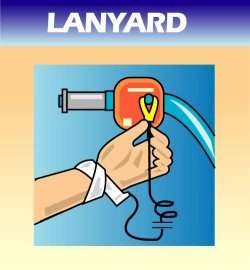Personal Water Craft
Recent History

Personal Water Craft (PWC) have become a major force in boating, accounting for a significant portion of new boat sales annually. There are more than one MILLION PWCs in use today.
That is a huge number of boats, and unfortunately there is an equal amount of misunderstanding to go along with them. Did you know that a PWC was even considered a boat? Many people don’t, and think of them more as toys that require no training or knowledge of how they work. To start, think of the terms used for a boat - they will be the same for a PWC.
When PWCs first came on the market, they were generally designed for only one person and were designed for high maneuverability. They were usually only available as stand-up models, and had few features.
Over the last several years, two, three and even four seat models have become the top sellers. These craft are much more substantial than earlier craft, and are even capable of pulling a water skier. Today's models generally come with a good deal of storage space for gear, and have a very traditional "dashboard" with gauges. Remember, your PWC operator's manual will tell you the specifics of your boat, including tips on safe operation, and how many people you can safely carry.
What they are

Personal Water Craft are considered by the Coast Guard to be Class A inboard motor vessels and as such must adhere to the same Coast Guard regulations and standards as any other powerboats in this category, such as they must have a fire extinguisher on board, and must have an appropriate sound signaling device such as a horn or athletic whistle.
They are also subject to USCG manufacturing and load capacity standards, which may be found on the capacity plate and in the owners manual.
They must be registered with the state, and must also obey the Nautical Rules of the Road.
Even though PWCs are considered to be boats, there are a few differences that you need to know.
Virtually no PWCs have running lights as all manufacturers recommend that they only be used during daylight. In fact, many states ban the use of PWCs at night.
Many states require that Personal Floatation Devices be worn at all times while on a PWC. Many states also regulate the operation of personal watercraft within their borders by prohibiting them from specified lakes and boating areas, or by placing geographic or time restrictions on their use.
Some states require an adult to be on board when a minor is operating the craft, or may require completion of a boating safety course before a minor can legally operate a PWC.
How they work

PWCs are operated by two-cycle inboard gasoline engines that drive a jet water pump. Water is taken in through a water pick-up on the bottom of the PWC, drawn into an internal propeller (an impeller) that creates a jet of high pressure water which exits through a nozzle on the back of the PWC.
There is also a moveable "gate" that can be dropped over the nozzle to provide reverse thrust on some models. Be careful, this is not designed to be used to stop a PWC operating at a high speed.
PWCs are designed to be extremely maneuverable. They are built for quick, sharp turns, low-radius circling, and rapid acceleration. However, they are only maneuverable with the throttle engaged – TO MAINTAIN STEERAGE, YOU MUST APPLY THROTTLE! For instance, the best way to avoid hitting an object is NOT to slow down, rather, you should apply throttle and steer away to avoid impact.
PWCs are self-righting if you fall off. Don’t abandon your vessel if it overturns. Simply turn it over on the direction marked on the hull or as indicated in the user’s manual that you read prior to use. Righting your craft improperly may make it more difficult than necessary to re-board, and you could cause internal damage to your PWC. To re-board your craft, approach the rear of the PWC, pull yourself up into a kneeling position, take your seat, start it up and continue on your trip. This sounds easier than it is – it is often quite difficult to re-board a PWC, especially in rough water or when fatigued. A good idea is to practice in calm shallow water before venturing out.
Most models have an automatic cut-off lanyard (which must be attached to the operator’s wrist or life jacket at all times) or self-circling feature to prevent a PWC from going far from a driver who has fallen off.
Practice boarding your PWC in a calm, shallow area with your friends or family. If you have difficulty getting back on a PWC from the water, you should most likely avoid using your PWC in areas where there is a strong current or high waves. There are "ladders" available to help you climb back on – definitely a worthwhile investment. Finally, don't forget to re-attach your cut-off lanyard.
When operating a PWC, keep clear of shallow water (less than two feet deep) or beds of sea grass or other vegetation. Since a PWC sucks water in to power its water jet, it is best not to operate in these waters. This will help keep dirt and debris from fouling the impeller, which could lead to power loss or damage to your PWC.
Operational Requirements
Legal requirements
As Personal Water Craft are considered to be type "A" motor craft, they must adhere to certain Coast Guard requirements as follows.
- Your PWC must be equipped with a marine-rated fire extinguisher and emergency signaling devices.
- All PWCs must be registered according to state regulations, and have a registration number displayed. Follow state guidelines for specific regulations.
- You must adhere to the manufacturer's listed capacity limits for people and equipment. Each PWC has an attached capacity plate that states what you may carry. Additional information may be found in your operating manual.
- Personal Floatation Devices must be worn by riders. Chose a properly fitting, Coast Guard approved PFD and WEAR IT.
- You may be required to take a boating education course prior to operating your PWC. Check your local laws.
Other gear you should consider
- Eye Protection - water spray can greatly affect your vision. Goggles or wrap around glasses offer the best protection.
- Foot Protection - Shoes or sandals will protect your feet and give you added traction.
- Gloves - Gloves will allow you to keep a tight grip on wet controls.
- Wet Suits - In colder water a wet suit will provide extra comfort by keeping you warm. Nettle suits will protect you from stinging nettles in the summer.
- Helmet - Many PWC accidents include head and neck injuries. Wearing a helmet and a high impact PFD with a neck brace will greatly reduce the effects of a high speed impact.
Pre-ride Inspection
It is always a great idea to check your watercraft prior to every outing. This will allow you to make sure that your watercraft is in top operating condition. Some things to check are:
- Battery - Make sure that your battery is fully charged, and all electrical wires are properly connected, tight, and not frayed.
- Controls - Make sure all operating controls are working properly - steering controls, stop button, lanyard cut-off, and throttle.
- Drain Plug - drain your bilge - and be sure your plug is properly secured before launching.
- Engine - Check your engine - fluid levels, hose connections, oil level/leaks, and finally make sure the engine compartment cover is properly secured.
- Fuel - Make sure that you don't have fuel leaks, and fill the tank. Plan on using 1/3 of your gas to get there, 1/3 to get back, and keep 1/3 as a reserve. Many PWCs are equipped with a fuel selector or reserve switch to help you avoid running out of fuel. If you run out of fuel, switch the tank setting to "reserve" and go to the dock. Don't forget to reset the switch once you've filled up again.
- Hull - Check the outside of your PWC--check for hull damage, check the jet pump cover and inlet for damage/fit, and secure the seats.
- Protection - A properly fitting life jacket, gloves, wetsuit, eye, head and foot gear, and a helmet will all help protect you from injury.
- Safety Gear - Make sure you have the required safety equipment - a fire extinguisher, signaling device(s) and all other legally required equipment. It's also a good idea to have an anchor, extra line, a boarding ladder, drinking water, and suntan lotion.
PWCs and the Environment
Pollution
- Refuel on land to reduce any chances of spilling oil or gas into the water.
- Slow down when filling the tank, don't over-fill, catch any accidental spills with an absorbent pad, and dispose of it properly.
- Check and clean your engine well away from shorelines. Water and oil don't mix and can harm the water's delicate micro-organisms as well as the animals who feed on them, potentially upsetting the entire food chain.
Turbidity
- In shallow waters, boats may stir up the bottom, suspending sediments which limit light penetration and depleting oxygen. This can affect fish and bird feeding. To avoid this effect, ride in main channels, and limit riding in shallow water.
- When it is necessary to ride in shallow water, keep watercraft at an idle speed. In coastal areas be aware of low tide. The waters may be substantially more shallow at these times revealing sea grass beds and other delicate vegetation.
Vegetation
Even though PWCs don't have an exposed propeller, you must take caution if you operate near shore. Vegetation such as sea grasses are delicate nursery grounds where many of the fish in our waters originate. Weeds, grasses and other plant life are not good for your PWC. Ingestion of these into your craft may cause engine or pump problems, and reduce performance. Stay Away.
When possible, operate well away from shore because, typically, wildlife inhabit the vegetation along the shore's edge. The least amount of disturbance is in the marked channels or the deeper areas of a lake or river. If at all possible, stay in main channels.
Excessive boat wakes may contribute to shoreline erosion, especially in narrow streams and inlets. Erosion is a concern for all shorelines including rivers, lakes, and oceans.
The slow destruction of shorelines affects the habitats of plants and animals. Near the shore avoid high speeds which create wakes and observe posted no wake zones.
Noise
Be aware that the noise and movements of boats may disturb bird populations. Steer clear of posted bird nesting areas.
Many migratory birds are easily stressed and especially vulnerable during their migration period. Birds will typically fly away from disturbing noises and any unnecessary expenditure of energy can harm a feeding or resting bird. Bird rookeries are especially vulnerable to noise from boats, including personal watercraft. Nesting birds may fly from the nest exposing unprotected eggs and hatchlings to the sun's heat or predators.
Wildlife Harassment
Do not harass wildlife by chasing or interrupting feeding, nesting, or resting. Harassment is defined as any action that may cause an animal to deviate from its normal behavior. It is illegal and can unduly stress wildlife. Mammals such as sea otters, sea lions, manatees and whales can be injured from direct impact by boats traveling at high speeds. Ride at controlled speeds so you can see any animals ahead of you. Avoid area of high animal population. If you hit an animal report it to your local wildlife commission. There may be a chance to save its life.
Docking & Beaching
One of the great features of having a jet drive is the ability to easily beach your PWC.
When docking or beaching, look for evidence of turtles, birds, alligators, manatees, and other animals along shore. Avoid docking or beaching where plants such as reeds, grasses and mangroves are located.
These plants are essential to the ecosystem because they control erosion and provide a nursery ground for small animals vital to the food chain, such as crustaceans, mollusks, and small fish.
Endangered Species

Many species of plants and animals are threatened with extinction due to habitat loss. The Endangered Species Act of 1973 was created to protect these animals. It is illegal to trade, kill, hunt, collect, harass, harm, pursue, shoot, trap, wound or capture species designated as endangered, or in danger of extinction, such as threatened, rare, and species of concern. The U.S. Fish and Wildlife Service is responsible for listing the hundreds of species in decline.
Be aware of the endangered or threatened species found in your riding area that are protected by a "safe haven". These protect them from human development, and creates an environment where they are allowed to survive and flourish.
Here are just a few endangered animals you might encounter while riding: brown pelican, manatee, southern sea otter, wood, stork, American alligator and whales.
Special Habitats
- Mangroves are a distinctive type of tree that have adapted to living in or near saltwater. There are four types of Mangrove trees, two of which are threatened with extinction. Many shore birds such as pelicans and roseate spoonbills nest in mangrove forests and islands. Mangroves shelter other marine life, control erosion and filter runoff. They also build up the shoreline and serve as a buffer that protects the land from storms and winds.
- Don't operate in un-marked mangrove channels, you're disturbing mangroves, birds, and other animals who reside in this area.
- Coral is a living organism which provides a safe haven for hundreds of marine creatures. This firm, yet fragile species is vulnerable to the effects of human intrusion. If you are riding near coral, do not use an anchor, and be careful when diving to avoid coming in contact with these delicate organisms.
Marine Plant Life
- Kelp forests support a lush underwater community teeming with fish, invertebrates, sea urchins and sea otters. Found close to shore, the kelp canopy covers the surface of the water and extends down, sometimes thousands of feet, to the bottom of the ocean floor. In warm months, this seaweed can grow as much as a foot a day.
- Sea grasses are nursery grounds normally found in protected waters called estuaries where fresh water and salt water meet. Most of the world's fish have their beginnings in estuaries and their associated sea grass habitat. Sea grasses are very delicate and their destruction can lead to degradation to the entire marine cycle.
- As a responsible PWC operator, stay away from both of these environmentally sensitive areas.
Preventing Accidents
Be aware of what is around you. The leading cause of PWC accidents is striking an object (usually another PWC). If you are operating your PWC in a congested area, slow down and look at what the boats around you are doing. To avoid being struck yourself, always look for other boats before making sharp or sudden turns.
Because PWCs are so small and maneuverable it is best to always give the other boats the right of way. Larger boats may not see you, and may not be able to get out of your way in time to avoid contact. Keeping a proper lookout can save your life.
As with any boat, operate at a safe speed. It is very easy to get thrown from a PWC, especially if you hit wakes or turn too quickly. Operating at a safe speed for the conditions will lower the risk of an accident.
If you lend your PWC to a friend, make sure they know the Rules of the Road and how to operate your PWC. A large portion of PWC accidents occur with rental PWCs or when people other than the owner are operating the vessel.
PWC Etiquette
With the rapid rise in the number of personal water craft, there have been many complaints about their use and misuse. Many people would love to see them outlawed altogether, and there are currently many local jurisdictions that are attempting just that.
With common sense and common courtesy, both PWC users and traditional boaters can coexist and enjoy their time on the water. Following some simple operating procedures can help eliminate the majority of complaints against PWCs.
Noise is probably the number one complaint about PWC use. Though manufacturers are continually developing quieter motor and exhaust systems (PWC motors all operate within legal limits for noise) there are many complaints about noise.
The best way to avoid noise complaints is to follow the Rules of the Road and also to avoid operating at high speed near the shoreline and other boaters. Riding through surf and boat wakes is not only dangerous, but in many states it is illegal to do either.
Don’t operate close to wildlife or aquatic vegetation. Even though PWCs probably have less of an impact on nature than many traditional boats, it is prudent to avoid boating in areas that could be harmful to the environment. Avoiding vegetation and debris will also spare your delicate propulsion machinery from unnecessary damage.
Obey the law! If all PWC users faithfully obeyed the law, there would be far fewer complaints, and consequently far fewer usage restrictions. PWC operators control their own destiny regarding new restrictions.
The PWC industry itself is a leader in responsible use of their products. The Personal Watercraft Industry Association has created a code of ethics for PWC users that really is valuable for all boaters.
PWC Code of Ethics
- I will respect the rights of all users of the recreational waterways, both on public waters and on adjacent private property.
- I will be considerate at the launch ramps and docks. I will get on and off the ramps quickly and not delay others. I will follow the navigation rules of the road around all other vessels. I will learn and observe my state’s rules on wake jumping.
- I will give all fishing, anchored, or drifting vessels plenty of room.
- I will always operate at headway speed in "no wake" zones.
- When approaching the shore, I will be especially aware of swimmers and other craft near the shore.
- I will not disturb wildlife. I will avoid areas posted for the protection of wildlife.
- I will not litter the shore side and I will be careful with my fuel.
- I realize that my travel speed should be determined by my equipment, ability, weather and wave conditions, and especially other vessel traffic. In case of emergency, I will volunteer assistance.
- I will not interfere with or harass others. I realize that people judge all personal watercraft by my actions.
- I will pay close attention to the noise my vessel may make and be aware of how others on boats and on shore react to that noise.
You Can Make A Difference
We all have a duty to the next generation to protect our bountiful natural resources. Take a moment to learn what the environmental concerns are in your riding area.
If you're interested in observing wildlife while riding, keep an idle speed to reduce wake, noise and turbidity (stirring up the bottom). Know your riding area for the safety of the environment, for your own protection, and for your personal watercraft's protection.

